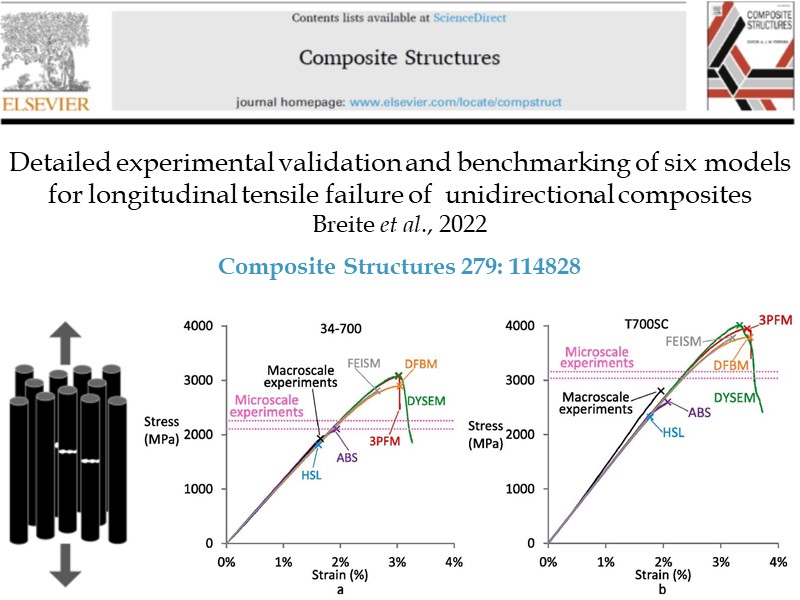
04 Mar Paper on experimental validation and benchmarking of six models for longitudinal tensile failure of unidirectional composites
Researchers of AMADE are coauthors of the paper entitled “Detailed experimental validation and benchmarking of six models for longitudinal tensile failure of unidirectional composites”, recently published at the scientific journal Composite Structures 279, 1 January 2022, 114828: https://doi.org/10.1016/j.compstruct.2021.114828
Longitudinal tensile failure of unidirectional fibre-reinforced composites remains difficult to predict accurately. The key underlying mechanism is the tensile failure of individual fibres. This paper objectively measured the relevant input data and performed a detailed experimental validation of blind predictions of six state-of-the-art models using high-resolution in-situ synchrotron radiation computed tomography (SRCT) measurements on two carbon fibre/epoxy composites. Models without major conservative assumptions regarding stress redistributions around fibre breaks significantly overpredicted failure strains and strengths, but predictions of models with at least one such assumption were in better agreement for those properties. Moreover, all models failed to predict fibre break (and cluster) development accurately, suggesting that it is vital to improve experimental methods to characterise accurately the in-situ strength distribution of fibres within the composites. As a result of detailed measurements of all required input parameters and advanced SRCT experiments, this paper establishes a benchmark for future research on longitudinal tensile failure.
The research leading to these results has been conducted in the framework of the FiBreMoD project and has received funding from the European Union’s Horizon 2020 research and innovation programme under the Marie Skłodowska-Curie grant agreement No. 722626. Compressive tests on the neat epoxy resin were performed at the mechanical lab of the Institute of Mechanics, Materials and Civil Engineering (IMMC), Université Catholique de Louvain (UCLouvain) with the kind support of J. Chevalier and T. Pardoen. M.J. Emerson from QIM, Technical University of Denmark (DTU) is thankfully acknowledged for the hands-on training sessions and support of the Insegt Fibre segmentation toolbox. Support of C. Schlepütz from TOMCAT beamline at Swiss Light Source for optimising the acquisition settings during the beamtimes under proposal IDs 20161157 and 20171494 is thankfully acknowledged. J.M. Guerrero would like to acknowledge the grant BES-2016-078270 from the ‘Subprograma Estatal de Formación del MICINN’ co-financed by the European Social Fund, and all authors from the University of Girona acknowledge the funding from the Spanish project RTI2018-097880-B-I00. The work of M. Hajikazemi forms part of the research programme of DPI, project 812 T17. S. Pimenta acknowledges the funding from the Royal Academy of Engineering in the scope of her Research Fellowship on “Multiscale discontinuous composites for high- volume and sustainable applications” (2015-2019). R.P. Tavares and P. P. Camanho would like to thank the financial support provided by FCT -Fundaçao para a Ciencia e a Tecnologia through National Funds in the scope of project MITP-TB/PFM/0005/2013. The authors would also like to thank A.R. Bunsell, S. Joannès, J. Rojek and A. Thionnet for their help in setting up the instructions.



